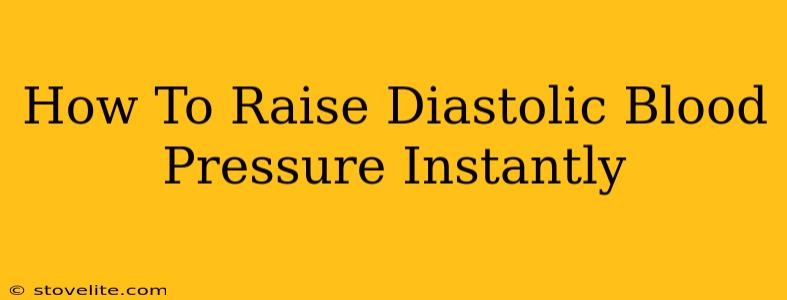Low blood pressure, or hypotension, can leave you feeling dizzy, lightheaded, and weak. While a slightly low reading isn't always cause for alarm, a significantly low diastolic blood pressure (the bottom number in a blood pressure reading) requires attention. This guide explores potential causes and safe ways to address a sudden drop in diastolic blood pressure. It is crucial to understand that this information is for general knowledge and should not replace professional medical advice. Always consult your doctor before making any significant changes to your health routine.
Understanding Diastolic Blood Pressure
Diastolic blood pressure measures the pressure in your arteries when your heart rests between beats. A consistently low diastolic reading (generally below 60 mmHg) is considered hypotension. While some individuals naturally have lower blood pressure, a sudden drop can indicate an underlying issue.
What Causes a Sudden Drop in Diastolic Blood Pressure?
Several factors can contribute to a sudden decrease in diastolic blood pressure, including:
- Dehydration: Lack of fluids reduces blood volume, lowering pressure.
- Medication side effects: Certain medications, such as diuretics and blood pressure medications, can lower blood pressure.
- Heart problems: Conditions like bradycardia (slow heart rate) or heart valve issues can affect blood pressure.
- Blood loss: Internal or external bleeding can dramatically reduce blood volume and pressure.
- Severe allergic reactions (anaphylaxis): A life-threatening allergic reaction can cause a drastic drop in blood pressure.
- Sepsis: A life-threatening complication of an infection.
- Endocrine disorders: Problems with your adrenal glands or thyroid can influence blood pressure.
- Nutritional deficiencies: Lack of essential nutrients can impact blood pressure regulation.
How to Raise Diastolic Blood Pressure (Temporarily and Safely)
It's important to emphasize that these methods are temporary solutions for a sudden drop and should not be used to treat chronic hypotension. If you frequently experience low blood pressure, you must consult a physician.
Immediate Actions for a Sudden Drop:
- Increase fluid intake: Drink water, clear broths, or electrolyte drinks to increase blood volume. Avoid sugary drinks.
- Eat salty snacks: A small amount of salt can temporarily help raise blood pressure. However, excessive salt intake is detrimental to long-term health.
- Elevate your legs: Raising your legs above your heart can improve blood flow back to the heart, temporarily increasing blood pressure.
- Wear compression stockings: These can improve circulation and support blood pressure.
- Avoid standing for long periods: This helps prevent blood pooling in the legs.
- Take slow, deep breaths: Deep breathing exercises can help regulate your heart rate and blood pressure.
Lifestyle Changes for Long-Term Blood Pressure Management (Consult Your Doctor First):
- Maintain a healthy diet: A diet rich in fruits, vegetables, whole grains, and lean protein is essential for overall health and blood pressure regulation.
- Increase your salt intake gradually and cautiously (with doctor's recommendation): Salt helps retain water, raising blood volume. However, excessive salt is harmful.
- Get enough sleep: Adequate rest is crucial for overall health, including blood pressure regulation.
- Manage stress: Stress can significantly affect blood pressure. Practice stress-reducing techniques like yoga or meditation.
- Regular exercise: Moderate exercise can improve cardiovascular health and blood pressure. Avoid strenuous exercise if you have low blood pressure.
- Increase your fluid intake: Staying hydrated is crucial.
When to Seek Immediate Medical Attention
If you experience a sudden and significant drop in diastolic blood pressure accompanied by any of the following symptoms, seek immediate medical attention:
- Severe dizziness or lightheadedness
- Fainting
- Blurred vision
- Nausea or vomiting
- Rapid or weak pulse
- Shortness of breath
- Chest pain
- Confusion
Disclaimer: This information is for general knowledge and does not constitute medical advice. Always consult your doctor or other qualified healthcare professional for diagnosis and treatment of any medical condition. Self-treating can be dangerous.

